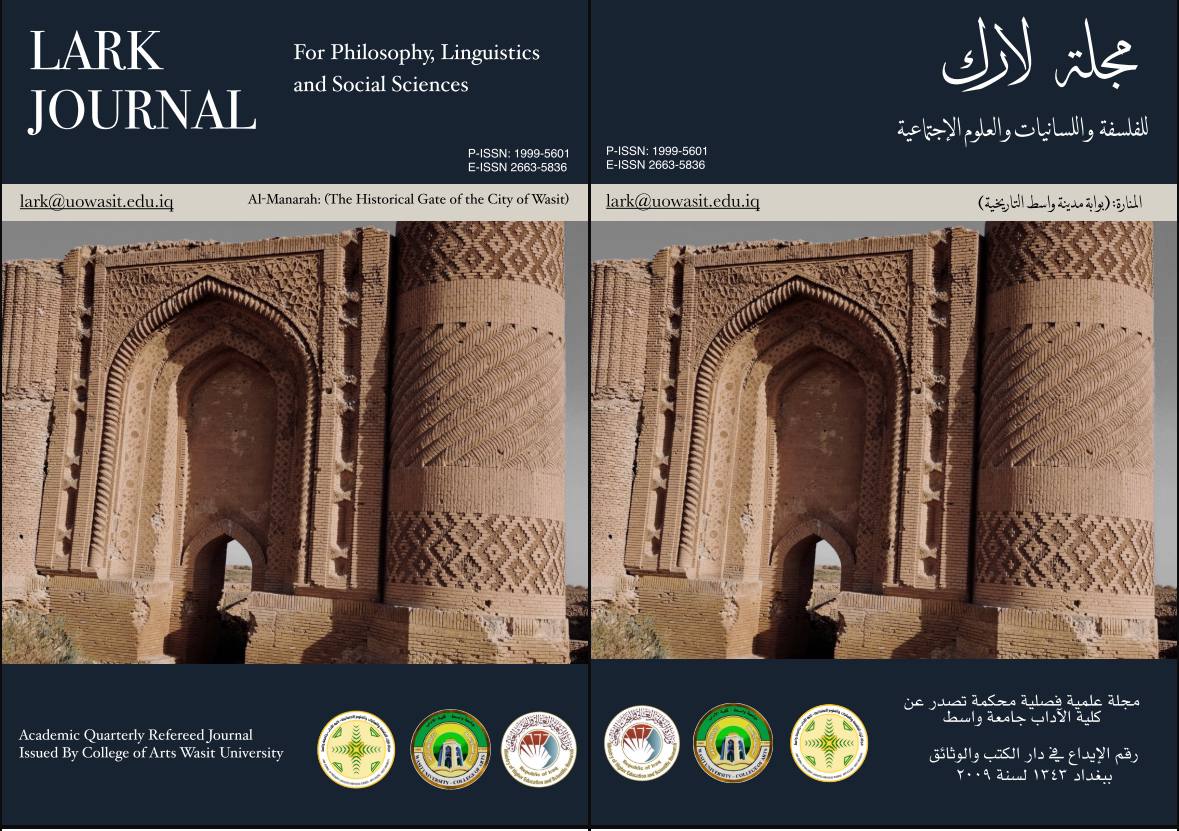The Impact of Machine Translation on Human Translation: Opportunities and Obstacles
DOI:
https://doi.org/10.31185/lark.4507Keywords:
Keywords: Machine translation, Human translation, Translation technology.Abstract
Abstract
Machine translation (MT) has emerged as a fundamental component of international discourse, enabling the instantaneous conversion of extensive quantities of information across linguistic boundaries. This article investigates the prospects and obstacles introduced by the proliferation of MT in relation to human translation. By analyzing the advantages in efficiency and accessibility provided by MT, while concurrently addressing concerns regarding quality and its ramifications for the labor market, this study presents a comprehensive assessment of the transformative influence of technological advancements on the translation sector. Primary data were obtained through qualitative interviews conducted with professional translators, in conjunction with an extensive review of existing scholarly literature. The results underscore a complex perspective: although MT presents considerable advantages, it is incapable of entirely supplanting the indispensable human element that is essential for proficient translation. This study analyzes the distinct linguistic challenges of Arabic, including (Modern Standard Arabic versus regional dialects), cultural and religious localization, and right-to-left technical constraints, through five sector-specific case studies that are: healthcare, legal, and media domains.
References
References
-Al-Emara, F. S., & Al-Sudani, Z. A. K. (n.d.). Translating political cartoons: Revision through crowdsourcing in light of game theory. College of Arts (Lark Journal), University of Wasit.
-Alfaifi, A. (2017). *Arabic dialect machine translation in healthcare settings: Challenges and solutions*. *Journal of King Saud University - Computer and Information Sciences*, *29*(2), 245-251. https://doi.org/10.1016/j.jksuci.2016.12.001
-Alharbi, M., Al-Khalifa, H., & Al-Salman, A. (2021). *E-commerce localization in the Arab world: Machine translation pitfalls and solutions* (Report No. 2021-03). Saudi Digital Language Foundation.
-Al-Qahtani, S. (2021). *Legal Arabic machine translation: Sharia compliance and GCC civil law*. Routledge.
-Alshehri, R. (2022). *Transcreation vs. translation: Marketing localization in the Arab world* [Doctoral dissertation, University of Leeds]. White Rose eTheses Online. https://etheses.whiterose.ac.uk/31245/
-Al-Worafi, M. (2020). *Lost in translation: Islamic medical ethics and machine translation*. In *Advances in Arabic Translation Technology* (pp. 117-134). Springer. https://doi.org/10.1007/978-3-030-33123-6_5
-Bouamor, H., Habash, N., & Oflazer, K. (2018). *A multidialectal parallel corpus of Arabic*. *Proceedings of the International Conference on Language Resources and Evaluation (LREC)* (pp. 1947-1953). European Language Resources Association.
-Darwish, K. (2019). *Right-to-left text formatting challenges in Arabic machine translation*. *ACM Transactions on Asian and Low-Resource Language Information Processing*, *18*(3), 1-22. https://doi.org/10.1145/3295662
- Freiermuth, M. R., & Bäuchle, G. (2019). "The future of translation: A human-centered approach." Translation Studies, 12(2), 208-222.
- García, I. (2019). "Post-editing machine translation: The state of the art and future perspectives." Machine Translation Journal, 33(1), 1-22.
- García, I. (2020). "Machine Translation and Accessibility: New Opportunities for Linguistic Inclusion." International Journal of Translation Studies, 92(3), 45-63.
-Habash, N. (2020). *Arabic natural language processing: Modern Standard Arabic and dialectal variations*. *Computational Linguistics*, *46*(1), 157-186. https://doi.org/10.1162/coli_a_00372
- Hutchins, W. J. (2005). "The history of machine translation in a nutshell." Translation Studies, 5(1), 103-126.
- Kenny, D. (2019). "Translation and technology: The impact of machine translation on the profession." Journal of Language and Translation Studies, 34(4), 511-526.
-Meftouh, K., Bouchemal, N., & Smaïli, K. (2015). *Machine translation challenges for Arabic dialects: A case study of Algerian dialect*. *Natural Language Engineering*, *21*(3), 407-437. https://doi.org/10.1017/S1351324914000253
-Mehdi, S. S. (n.d.). Interdependent relationship between contrastive analysis and translation. Department of Translation, College of Basic Education, Al-Mustansiriyah University.
-Obeid, O., Zalmout, N., Khalifa, S., Taji, D., Oudah, M., Alhafni, B., Inoue, G., Eryani, F., Erdmann, A., & Habash, N. (2023). *CAMeL Tools: An open-source Python toolkit for Arabic natural language processing*. *Proceedings of the 22nd Workshop on Arabic Natural Language Processing*, 1-8. Association for Computational Linguistics.
-O'Brien, S. (2018). "The cost effectiveness of machine translation in the modern marketplace." Translation and Localization Management, 3(2), 89-101.
- Pérez-Ortiz, P. (2021). "Evaluating machine translation quality: Methods and practices." Journal of Translation Research, 17(2), 67-85.
-Qatar Computing Research Institute. (2023). *Farasa: A toolkit for Arabic natural language processing* (Version 3.2) [Technical report]. Hamad Bin Khalifa University. https://farasa.qcri.org
-Shakir, A. A. M., & Al-Ka’by, R. (n.d.). A study of strategies of English to Arabic collaborative translation on the Zoom platform. College of Arts, Mustansiriyah University.
- Simard, K. S., et al. (2019). "Technological advancements and machine translation: Enabling translations of low-resource languages." Journal of Language Technology, 10(4), 233-245.
-Taban, D. A., Al-Zuky, A., Al-Saleh, A. H., & Mohamad, H. J. (n.d.). Machine intelligent system algorithm to recognize different shaped color targets. Departments of Physics and Computer Science, College of Science, Mustansiriyah University.
-Tarjama. (2023). *Arabic post-editing cost analysis: Industry benchmarks for machine translation* [White paper]. https://www.tarjama.com/research
- TNS Global. (2021). "The Translator's Perspective: Adoption of Machine Translation in Professional Settings." Global Translation Trends Report.
- Vaswani, A., Shard, N., Parmar, N., Uszkoreit, J., Jones, L., Gomez, A.N., Kaiser, Ł., Kottur, S., et al. (2017). "Attention is all you need." Advances in Neural Information Processing Systems, 30.
- Venuti, L. (2018). "The Translator's Invisibility: A History of Translation." Routledge.
-Zbib, R., Malchiodi, E., Devlin, J., Stallard, D., Matsoukas, S., Schwartz, R., Makhoul, J., Zaidan, O. F., & Callison-Burch, C. (2019). *Neural machine translation for Arabic dialects*. *arXiv preprint* arXiv:1906.10862. https://arxiv.org/abs/1906.10862
Downloads
Published
Issue
Section
License
Copyright (c) 2025 الباحثة: مودة رحيم كوكز

This work is licensed under a Creative Commons Attribution 4.0 International License.





